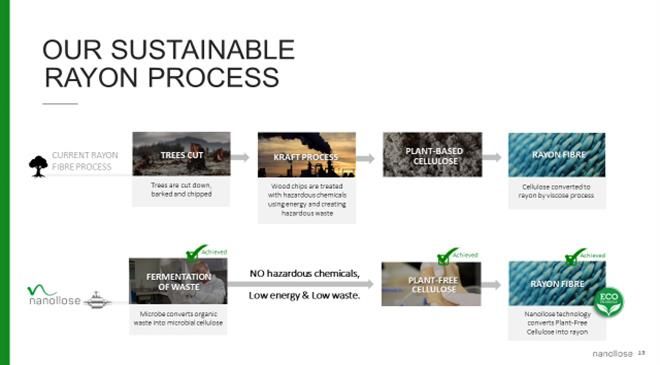World's first plant-free viscose-rayon fibre
Australia-based biotech startup Nanollose is using advanced cellulose technologies to generate new and improved fibres and other materials in an environment-friendly and sustainable manner. CEO Alfie Germano tells us about the path-breaking discovery and journey of making plant-free cellulose for textiles.
Who are the major investors in Nanollose? How do you plan to use the recently raised funds for Nanollose?
The company was listed by a high-profile Western Australian group called Mac Equity. Our investor base is mainly made up of their high net-worth client base that supported the company in the $5m initial public offer. These funds are being used to accelerate the development of the company's fibre technologies and build production supply chains with all end-to-end key partners.
Tell us about the story of Nanollose. How did you come up with the idea of plant-free cellulose?
Interestingly, one of our founders Gary Cass is an agricultural scientist. He discovered our plant-free cellulose, which actually materialised over a decade ago while working on a vineyard serendipitously when he mistakenly flooded a vat of wine with oxygen. What remained from his spoilt batch was a leather-like substance, which came from a friendly bacterium called acetobacter, which feeds off the wine. It is ironic that a mistake made decades ago could potentially and positively impact a new sustainable fibre solution.

What is the kind of research that went into developing such a unique fibre?
Following the initial discovery, Cass spent years contemplating potential uses for the fibre-like substance. Then in 2006, he teamed up with Perth fashion designer Donna Franklin and released the world's first dress made from wine. And in 2014, he showcased a dress made from beer at the World Expo 2015 in Milan. While these dresses were only for marketing and experimentation purposes, it wasn't until late in 2017 that the company produced what we believe to be the world's first plant-free viscose-rayon fibre.
We humbly feel that this is a significant global breakthrough for the textile and clothing industries when you juxtapose it against the current viscose-rayon norm, where the fibre is made from cellulose, which is extracted from trees using environmentally challenging processes. So it has been a long journey, but we are now accelerating the commercialisation of the Nanollose technology and aim to make significant progress in being able to provide a sustainable alternative to the clothing industry over the next 12 months.
Any plans to open subsidiaries elsewhere?
The short answer is we have no plans to open subsidiaries. Our focus is to heavily collaborate with key partners.
How is Nanollose different from the regular cellulose?
Regular cellulose comes from trees and plants. Nanollose's cellulose does not come from plants and trees.
We are a future tech company that applies its technology to various liquid waste streams to extract cellulose, which in turn goes towards making scalable raw materials for making textiles and other applications. This is a departure from the current use of cotton and wood to extract cellulose to make fibres for clothing, whose supply chains and procurement ecosystems have rising and ever-growing environmental concerns.

Please explain this entire concept in layman's terms.
In layman's terms, today we cut down trees to make fibres and clothes. Nanollose is a company that has developed a technology to use liquid waste and convert the same into fibres that can go into the making of clothes. Less trees will be cut down in future.
Our cultivation or cellulose comes from an eco-friendly fermentation process that requires very little land, water or energy. Certain microbes can be introduced to liquid waste streams from various large-scale industries like beer, sugar and food juices. These microbes convert this liquid biomass into cellulose. From here, we apply our technology to the plant-free cellulose, which converts it into valuable fibre for the textile and clothing industries.
Is it cheaper to extract cellulose fibre through biomass from waste products? What is the process involved?
The early stage indication is that we can expect to become cost competitive with traditional plant based methods of extracting cellulose over time. The procurement capital expenditure is lower as we don't require vast acres of land to grow trees or cotton, and our process excludes the need for large industrial processing plants like those used to extract cellulose to create rayon fibres from wood pulp. Another factor is the lower feedstock costs from repurposed waste streams over time that will assist in equalising cost to industrial norms.
Another factor in lowering cost is around growth cycles. Our growth and harvest cycle for microbial cellulose is 18-20 days compared to the 6-8 months needed to grow cotton or the 12-18 years to grow trees.
This significant rise in yield cycles is a plus when building capacity and speed to market and we have commenced talks with raw material partners to plan and scale up the MC supply chain.

What is the technology being used to develop plant-free cellulose?
As mentioned before, our process uses Acetobactor xylinum, a non-hazardous bacterium that converts biomass waste products into cellulose. Our technology fits into the existing infrastructure and this seamless transfer offers an opportunity to scale up. Unfortunately, at this point I cannot mention the specifics about how we take our plant-free cellulose and create high-value fibre products like viscose-rayon.
Is the technology patented? Are there other plant-free cellulose fibres available?
Currently we are not aware of any other eco-friendly plant-free viscose-rayon fibres available to textile and clothing manufacturers. This puts us at a significant first mover advantage in offering a sustainable rayon alternative. In light of this, we are very progressive in ensuring our technology is protected and so we filed our first foundational patent late last year. As we increasingly pursue new commercial opportunities surrounding sustainable fibre products, the company will continue to expand its patent portfolio to protect these breakthroughs.

Where is your unit located? What is its capacity? Where are you sourcing all the waste products from?
We are headquartered in Perth, Australia. We have a small-scale research and development facility and work with a local world-class industrial lab. We don't plan on building a larger-scale facility at this stage. Instead, our vision is to license and partner with various industrial third parties to manufacture our plant-free cellulose, which will then be converted into sustainable fibre products.
The infrastructure is out there ready to be augmented or repurposed. Or as we say, we don't make the dots, we connect them.
In terms of sourcing the feedstock, we have initially been talking with a coconut industry partner in South East Asia. We are making steps to secure pilot-scale and ramp up supply levels of microbial cellulose. Our next step is to secure other sources of liquid organic waste (beer, wine, sugar) as a feedstock in order to continually build a larger and diverse scale of microbial cellulose.
Working closely with these industries is where we have unlocked significant mutual benefits. Each year companies pay millions to treat and properly discard their waste to be water compliant. Together we can work on a supply chain that could repurpose the waste, reduce costs and create new industry opportunities.
What is the carbon footprint that Nanollose will leave compared to cellulose?
We simply take out the cutting down of trees and any chemical extraction of cellulose. I think most could conclude that this is a significant reduction. In future, we can share more scientific data that juxtaposes the current with the proposed alternative. (see illustration below)

How do you plan to make this technology available to textile and apparel manufacturers?
Progressive brands and companies are starting to facilitate this new eco shift by involving themselves deeper in the supply chain and searching for feasible, sustainable, long-term fibre alternatives. We want to work with these commercial partners who will take and accelerate the Nanollose fibre technology to global markets.
Our vision is to license our technology to these groups and ensure there is no major retrofitting of machinery and processing needed. We are currently working towards offering a turn-key process to replace current fibres and hope that there will also be an enormous sustainable PR opportunity for partners.
Do you already have clients on board? If yes, which regions do they hail from?
Over the past three months, interest from multiple textile, apparel and fibre manufacturers has been significant. We are currently in early stages of discussions with them all. These range from high-end designers to mass-market textile brands and retailers, to personal hygiene companies and even groups from the European automotive industry.
How pliant would the yarn be? Will it be usable by the apparel sector or would it be confined to packaging, etc?
The yarn has various characteristics that are suitable over multiple textile sectors and also applicable to other sectors, including packaging. Nanollose's main focus is "all" things textile.
Will the yarn be amenable to blends with other natural or artificial fibres? Does it have the potential to be used to develop smart fabrics?
The initial data suggests the yarn will be comparable to current cellulosic yarns, therefore it can be blended with other fibres (natural and man-made) and possibly augmented in smart or performance fabrics.
What would be the cost of adopting the technology? By when will that be available to textile manufacturers?
We have designed our technology to fit into the current infrastructure with little retro fitting costs. All technology-related cost is in the licensing. Our goal is to make it highly affordable and make it commercially available to textile manufacturers. (HO)






